RF Connectors / test equipment connectors from WA1MBA (original) (raw)
RF CONNECTORS FOR UPPER FREQUENCIES
This page developed by Tom Williams, amateur radio callsign WA1MBA. It is meant for reference use. Do not copy or publish without permission and citation. If asked, permission is usually granted for educational, internal commercial, and reference use.
Background
This page describes small RF connectors, focusing on those which perform at microwave frequencies (well above 1 GHz). Included are SMA, K, BNC, N, APC-7 mm, SMB, SMC, W, V, 3.5 mm, 2.9 mm, 1.85 mm and 1.0 mm. Much of this information was taken from Hewlett Packard/Agilent application notes and catalogs, Wiltron/Anritsu datasheets, M/A-Com catalogs, and other sources. If you have more and/or better information about small RF connectors, please let me know (see bottom of page).
Why different connectors?
Many coaxial connector types are available in the RF and microwave industry, each designed for a specific purpose and application. Much of the development of the smaller connectors that perform well into the GHz and millimeter wave range has been conducted by test equipment measurement companies. One of their considerations is the number of connect-disconnect cycles that a connector pair can withstand while still performing as expected.
Below, the connectors are arranged into three categories: Primary Interconnects - widely used to interconnect RF equipment and components, Less Common Interconnects - connectors that are used to interconnect RF equipment and components, but are less widely in use, and Connectors for Precision Measurement Systems - which, as the title implies, are usually found only interconnecting and mating to measurement apparatus such as spectrum and network analyzers. Radio Amateurs may run across precision measurement connectors when buying flea-market items because those items are useful in microwave interconnection even though they were originally intended for measurement systems.
Why different sizes and frequencies?
The frequency range of any connector is limited by the excitation of the first circular waveguide propagation mode in the coaxial structure. At the bottom of this page is a reference to an on-line calculator which allows you to figure out the cutoff frequency of coaxial structures. Decreasing the diameter of the outer conductor increases the highest usable frequency. Filling the airspace with dielectric lowers the highest frequency and increases losses. The mating process typically changes the geometry of the mating surfaces and resistance loss at those interfaces as well as geometric changes result in variation of impedance and loss.
Some RF connectors are sexless (such as the HP/Amphenol APC-7 and the General Radio GR874). Most connectors have female structures with slotted fingers that introduce a small inductance. The fingers accommodate tolerance variations, but reduce repeatability and may ultimately break after 1000 connections. There are slotless versions of connectors available, but they are, for the most part, relegated to instrument interfaces. Slotless female connectors are very difficult to clean and require very careful connection and disconnection.
Primary Interconnects
Type N
The Type N 50 ohm connector was designed in the 1940s for military systems operating below 5 GHz. One resource identifies the origin of the name as meaning "Navy". Several other sources attribute it to Mr. Paul Neil, an RF engineer at Bell Labs. The Type N uses an internal gasket to seal out the environment, and is hand tightened. There is an air gap between center and outer conductor. In the 1960s, improvements pushed performance to 12 GHz and later, mode-free, to 18 GHz. Hewlett Packard, Kings, Amphenol, and others offer some products with slotless type-N outer conductors for improved performance to 18 GHz. Type-N connectors follow the military standard MIL-C-39012. Even the best specialized type-N connectors will begin to mode around 20 GHz, producing unpredictable results if used at that frequency or higher. A 75 ohm version, with a reduced center pin is available and in wide use by the cable-TV industry.
BNC and TNC
The "Bayonet Neil-Concelman" or "Bayonet Navy Connector" or "Baby Neil Connector", depending on the information source. Karl W. Concelman is believed to have created the "C" connector. The BNC was designed for military use and has gained wide acceptance in video and RF applications to 2 GHz. The BNC uses a slotted outer conductor and some plastic dielectric on each gender connector. This dielectric causes increasing losses at higher frequencies. Above 4 GHz, the slots may radiate signals, so the connector is usable, but not necessarily mechanically stable up to about 10 GHz. Both 50 ohm and 75 ohm versions are available.
A threaded version (TNC) helps resolve leakage and geometric stability problems, permitting applications up to 12 GHz. The specifications for N, BNC and TNC connectors are found in MIL-C-39012. There are special "extended frequency" versions of the TNC that adhere to the IEC 169-17 specification for operation to 11 GHz or 16 GHz, and the IEC 169-26 specification that operate mode-free to 18 Ghz (but with significant losses). The TNC connector is in wide use in cellular telephone RF/antenna connections. Because the mating geometries are compatible with the N connector, it is possible to temporarily mate some gender combinations of BNC and N. This is not a recommended use because the connection is not mechanically stable, and there will be significant impedance changes at the interface.
SMA
The SMA (Subminiature A) connector was designed by Bendix Scintilla Corporation and Omni-Spectra Corporation as the OSM connector, and is one of the most commonly used RF/microwave connectors. It is intended for use on semi-rigid cables and in components which are connected infrequently. It takes the cable dielectric directly to the interface without air gaps. The threads are 0.250 x 36, and the male has a 0.312 hex body, tightened with a 5/16 inch wrench.
A few hundred interconnect cycles are possible if performed carefully. Care should be taken to join connectors straight-on. Prior to making a connection it is wise to inspect the female end to assure that the center socket is in good condition (fingers not bent or missing).
A standard SMA connector is designed for interconnects to 12.4 GHz. Fortunately, a good SMA is useable to 18 GHz in most cables, and if well constructed with greater loss and lower return loss to 24 GHz. Most SMA connectors have higher reflection coefficients than other connectors available for use to 24 GHz because of the difficulty to anchor the dielectric support. Some manufacturers rate a special high quality version of an SMA that meets SMA standards as high as 26.5 GHz (The Johnson Field Replaceable SMA goes to 26.5 GHz, and the M/A-Com OSM extended frequency series goes to 27 GHz). Because an SMA with such quality can be repeatably manufactured, you will often see test equipment and components rated to exactly 26.5 GHz with SMA connectors as the primary interconnect.
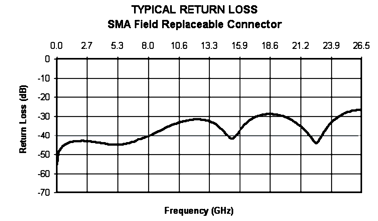
Here is the Return Loss of the Johnson Components Field Replaceable SMA connector. This is mounted on a chassis, not a cable. The return loss bumps at 12.4, 18, and 26.5 GHz are indications of SMA geometric constraints that have led to those specific frequency limitations in some SMA connectors.
"SMA" connectors rated for frequencies higher than 27 GHz are really following other standards and are made to be compatible with the SMA geometries to allow mating with SMA. So called "precision SMA" connectors are available with a variety of designators (see 3.5 & 2.92 mm section below). Precision SMA connectors rightly belong both in "primary interconnects" and "precision measurement" categories because they are meant to bridge the gap between the two uses. When two SMA compatible connectors of different ratings are coupled, it is very likely that the performance of the lesser connector will prevail, but as a chart below will show, some improvement over the lesser connector can be achieved.
7/16 DIN
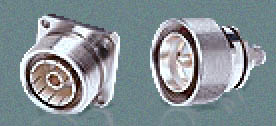
Female and Male 7/16 connectors
This relatively new connector is finding popularity as an interconnect in cellular and other so called "wireless" applications, especially on towers. The primary advantage it has over N type connectors is that it uses a wrench to tighten. The 7/16 follows the DIN 47223 specifications. It is rated to 7.5 Ghz, uses rubber gaskets and silver or gold plate.
Other Common Interconnects
There are many other common RF interconnects, but are not described in this treatment because their performance in the microwave region is very limited. Examples are C, HN, SC, LC, various EIA, UHF, mini-UHF, Motorola, HV, SHV, and RCA Phono.
UHF ConnectorThe much maligned UHF connector for any frequency above 50 MHz is perhaps not as bad as many have said. It does have problems, but also had advantages at least at frequencies below 2 GHz. For that reason there is another page where K2RIW describes the ins and outs of this connector.
For information about the UFH connector, click here.
GR874
"G874", "GR874", or just plain "874" connectors are sexless, 50 ohm connectors developed by General Radio. It is a test equipment connector which is fairly easy to mate. Some have locking interfaces to secure them. Normally, it is made of Teflon with Beryllium Copper contacts and Nickel plated. The mating portion of the connector is air dielectric. Frequency range to 8.5 GHz. See http://www.deltarf.com/pdf/Delta874.pdf for details on commercially made current versions of this connector. This connector is apparently not being used on new equipment.
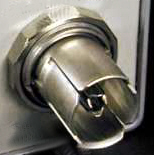
GR874 (sexless) on piece of test equipment.
Less Common Interconnects
SMB
The Subminiature B connector is a snap-mount connector rated at 4 GHz, but usable to 10 GHz. The Mil standard is MIL-STD-348. Typical insertion loss is as much as 0.3 dB at rated frequencies, making this connector a poor choice in critical low noise microwave RF interconnects, but quite acceptable in other signal delivery applications. SMBs can be used up to 10 GHz without moding. They are designed for 500 interconnect cycles.
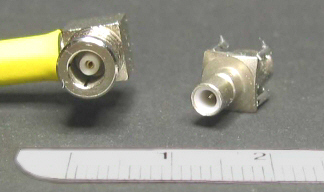 Male and Female SMB connectors, scale is cm (Image from www.ham-radio.nl)
Male and Female SMB connectors, scale is cm (Image from www.ham-radio.nl)
SMC

A Female SMC connector
The SMC (Subminiature C) developed in the 1960's is a threaded type interface connector, much smaller than an SMA connector, making it suitable for some applications with size constraints. The threads are 10-32, and it is not gasketed. Much like a very small version of the TNC, dielectric appears in both the male and female connectors. It was originally intended for use up to 4 GHz. If made according to MIL STD-348, it can be used successfully to 10 GHz, but with increased loss. The SMC is generally a good substitute for the SMB where vibration is a concern.
OSSM and SSMA

Female and male SSMA connector
- Sub-SMA, a small version of the SMA connector, about 70 % size. It uses a 0.190 in x 36 tpi thread (10-36). The standards vary regarding performance. One manufacturer quotes performance to 26 GHz. Another to 36 GHz, and still another (M/A Com) has a standard version that operates mode-free to 38 GHz, and a special high performance version which is mode-free to 40 GHz.
SSMB- Sub-SMB, a small version of the SMB connector, about 70% size. No specifications yet.
SSMT- Sub-SubMiniature, a snap-on 6 GHz connector, 100 interconnect cycles. This connector is very small. Usually the male is mounted on a circuit board. The male has a small center pin, is primarily plastic and has a small metal ring embedded in the plastic which serves as the outer diameter. The connector uses air dielectric. (thanks to Chad Wangsvick for help with this info)
OSMTM/A-Com - A blind mating connector, very similar to the SSMT but slightly larger. Rated to 6 GHz.
OS-50PM/A-Com - A blind mating version of the OS-50 2.4 mm connector, rated to 40 GHz, and about 1/2 the size of an SMA connector, 500 interconnect cycles
BMA & OSP

A female BMA connector
M/A-Com -A blind mating connector, some are only rated to 6 GHz with 500 interconnect cycles, many are rated to 18 GHz, and there is a stainless steel high-grade version rated as a 22 GHz connector, and designed to operate 5,000 interconnect cycles.
OSMP M/A-Com -A push-on 6 GHz connector, rated to 40 GHz, 100 interconnect cycles
OSSPM/A-Com - A blind mating connector, rated at 28 GHz, and designed to operate 1,000 interconnect cycles.
GPO and GPPOGilbert - The GPO is rated to 40 GHz, and depending on detent type, it can withstand from 100 to 1,000 interconnect cycles. The GPPO is 30% the size of the GPO and is rated to 65 GHz.
SMP and SSMPConnecting Devices Inc - These connectors are very similar to the GPO and GPPO.

Some Connecting Devices Inc SMP and SSMP connectors
NanohexITT - A sub Subminiature available in both snap and screw interfaces, rated at 12.4 GHz.
MCX Family

Female MCX / OSX
The MCX Family (MCX and MMCX) are snap-on 50 Ohm connectors similar to SMB that follow the European CECC 22220 standard. M/A-Com part OSX is equivalent to the MCX. Both MCX and MMCX are rated for 0 - 6 GHz operation. The MCX is about 70% of the size of an SMB (but not compatible with the SSMB) and is rated at about 250 V (max working voltage) and the MMCX is about 50% of the size of an SMB and rated at about 170 V max working. It appears the MMCX stands for Micro-Mate C. These connectors are designed to permit at least 500 interconnect cycles.
Connectors for Precision Measurement Systems
APC-7 (7 mm)
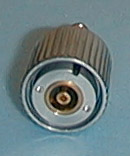
APC-7 connector (sexless)
The APC-7 (Amphenol Precision Connector - 7 mm) offers the lowest reflection coefficient and most repeatable measurement of all 18 GHz connectors. Development of this connector was a joint effort between HP and Amphenol which began in the early 1960s. This is a sexless design and is the preferred connector for the most demanding applications, notably metrology and calibration. These connectors are designed to perform repeatably for thousands of interconnect cycles as long as the mating surfaces are kept clean. You will find these connectors on the front of some network analyzers. Adapters are available to SMA, N, Waveguide and other precision connections.
Precision SMA Compatible
Various "Precision SMA" connectors have been developed in order to reduce reflection coefficients, and allow mating with better connectors. There are two basic geometries (which are not true SMAs), one is the 3.5mm/Wiltron WSMA, and the other is the 2.92mm/Wiltron K. All connectors in this family mate to one another. The threads are 0.250 x 36, and the male has a 0.312 hex body, tightened with a 5/16 inch wrench (with different torque depending on type).
There is a question about mating an SMA with a 3.5 or 2.9, regarding the possibility of damaging the 3.5/2.9 female when a male SMA is inserted. These precision series are less likely (than SMA) to be damaged when being connected to their exact mates (because the geometries of the mating for precision 3.5 and 2.9 is superior to the SMA). There is the possibility of damage to the (unsupported) female fingers of the 3.5/2.9 if an SMA male is inserted other than perfectly straight-on, or if the SMA is improperly prepared with a pin that is too long. Indeed, an excessively long pin can and probably will seriously damage the female fingers of a 3.5/2.9. The damage is likely to be permanent.
One lab engineer has commented that even professionally manufactured and assembled SMAs can have their pin length change if the semi-rigid coax to which they are mounted is subsequently bent near the connector. Furthermore, even if an intermediate "connector saver" adapter is used, it is possible to push the pin through and damage the 3.5/2.9 female.
So, be advised that when mating a male SMA to a female "Precision SMA", to be sure that the SMA male is of professional manufacture, and to insert the male straight-on. If there is any doubt, it is wise to invest in an SMA Connector Gauge, and gauge the SMA male prior to mating. This advice does not apply to the connection of an SMA female to a 3.5 or 2.9 male. Such connections need to be made with care and straight-on, but there I have received no reports of damage. Connector gauges can be found at SRI Connector, and Maury Microwave. Both companies also sell precision connectors.
By the way, my English language resources indicate that the primary spelling of the word that means "to check for conformity to specifications or limits" is spelled with the "u" in the middle. On last reading, both SRI and Maury spell this word in its variant form, without the "u". I am a lousey speller, so I will stick with the dictionaries on this one.
3.5 mm or APC-3.5
The 3.5-mm connector was primarily developed at Hewlett Packard, with early manufacturing at Amphenol. In some places you will see this connector designated as an APC-3.5. Its design strategy focused on highly rugged physical interfaces that would mate with popular SMA dimensions, allowing thousands of repeatable connections. It is mode-free to 34 GHz. Note that UT-141 coax also modes at 34 GHz, so this connector is very well suited to this coaxial cable. One obvious difference between the 3.5 and the SMA is that the 3.5 uses an air dielectric throughout the connector. The diameter of the inside of the outer conductor (in the connector) is 3.5 mm. The outside of the outer conductor is kept at 4.55 mm to be compatible with the mating surfaces of the compatible series. When mated with SMA and other precision SMA type connectors the performance is limited by the connector with lesser performance. There are some male versions of this connector with a large knurled shell for hand tightening, especially on instrumentation cables. This allows quick connection without a wrench.
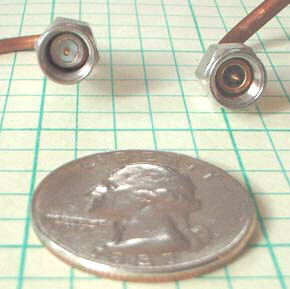 SMA Male on left, 3.5mm Male on right SMA Male on left, 3.5mm Male on right |
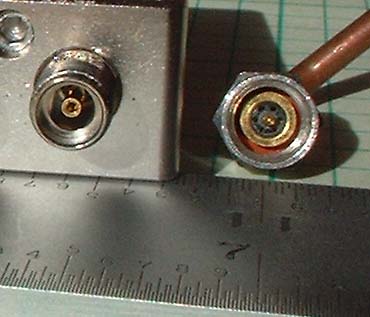 3.5mm Female on left (air), 3.5mm Male on right (black dielectric) 3.5mm Female on left (air), 3.5mm Male on right (black dielectric) |
|---|---|
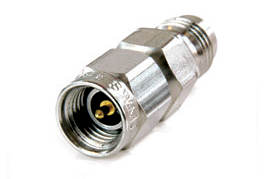 A 3.5 mm Male connector (Photo courtesy of Southwest Microwave) A 3.5 mm Male connector (Photo courtesy of Southwest Microwave) |
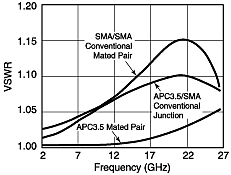 3.5 mm and SMA mating SWR 3.5 mm and SMA mating SWR |
WSMA
The Wiltron SMA, so called "WSMA" is an example of a precision SMA type connector, useful for both interconnects and for precision measurement. When mated with the Wiltron K connector (see below) gives quite good performance to 33 GHz. The WSMA is very similar to the HP 3.5 mm.
"K" and 2.92 mm
The K connector is trademarked by the Wiltron Corporation, and developed during 1983. The Wiltron Corporation is now part of the Anritsu Corporation. Also known as the 2.9 mm, the K mates with SMA and 3.5 mm connectors (and the Wiltron WMSA and other 2.92 mm), and offers mode-free performance to 40 GHz, usable to 46 GHz. As recently pointed out to me, this was announced at the 1984 MTT symposium and exhibition. Some manufacturers call this the "2.9" and others the "SMK".
The K and 2.92 equivalents use an air dielectric. The diameter of the inside of the outer conductor (in the connector) is 2.92 mm. The outside of the outer conductor is kept at 4.55 mm to be compatible with the mating surfaces of the compatible series. The K can be mated directly to the SMA, the 3.5 mm, and the WSMA. See the table below for mated performance. As with the 3.5 mm, there are some male versions of this connector with a large knurled shell for hand tightening, usually found on instrumentation cables. This allows quick connection without a wrench.
Although originally designed to operate with exceptional performance between K connectors to at least 20 GHz, a mated pair of Ks may indeed be used up to 46 GHz. Note that UT-141 coax begins to mode at 34 GHz and UT-085 begins to mode at 61 GHz. Additionally, the K connector has been successfully tested at over 10,000 (careful) interconnect cycles with negligible change in performance. The male K connectors that I have seen use a black dielectric with holes in it to reduce loss levels to that of air dielectric, while maintaining physical support of the pin.
Other 2.92It appears that the performance of the HP 2.92 mm connector is identical to the K connector (see above). However, the exact geometric tolerance limits are different by as much as .002 inches. The tolerances significantly overlap, so that if you had one of each under the microscope they may in fact look and measure the same, and so, the K and 2.92 mm are essentially the same connector. The K connector has been available as the M/A-Com OS-2.9 Coaxial connector, which is licensed to M/A-Com by Wiltron/Anritsu.
2.4 and 1.85 mm Geometries
The 2.4 and 1.85 mm geometries were designed to go beyond the SMA interface constraints, and as a result are NOT SMA compatible. Instead, maximum performance to the highest possible frequency that the geometry would allow, along with repeatable measurements after hundreds or even thousands of interconnects were the design goals. The male hex head is the same outer size as an SMA, 0.312 in, tightened with a 5/16 inch wrench. The threads, however, are metric, at M7 x .76-6G. To tell the difference between this family and the SMA by casual visual inspection, note that there is quite a thick outer conductor with a very narrow air gap between it and the center conductor in both of these connector types.

Male 2.9 mm SMA compatible connector on left,
and male 2.4 mm (NOT SMA compatible) Connector on the right.
Photo courtesy RFCoax Inc.
It can be difficult to distinguish between a 2.9 mm SMA compatible and a 2.4 mm (non-compatible) unless they are next to each other (see photo above). Because they are not mechanically compatible, if you have a male and a female SMA of professional manufacture (carry one of each with you to flea markets), you can put them next to the connector under question and decide whether it is an SMA compatible or a 2.4/1.85. The next test would be to carefully try to insert the SMA onto the unknown. If the unknown is a 2.4 or 1.85 , it will not fit. The threads are quite different both in diameter and pitch. The barrel of the female 2.4 (being larger than the SMA) will prevent insertion of the male SMA. A 2.4 Male might fit over an SMA female, but it will be immediately clear that they are not compatible. Do NOT use force. As noted above in the section on Precision SMA, if the connector under question is a 2.9 or 3.5 female, it will be compatible with the SMA but not with a 2.4 or 1.85 mm.
Male and Female 2.4 mm connectors
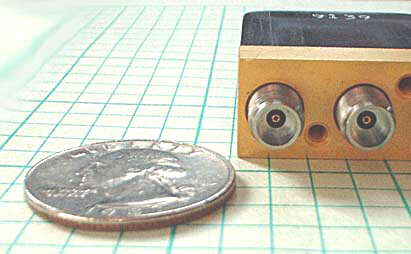
Two Female 2.4 mm connectors
2.4 mm
The 2.4 mm connector was developed by HP, Amphenol and M/A-COM for use to 50 GHz (the first waveguide mode is reached at 52 GHz). Note that UT-141 coax modes at 34 GHz, and UT-085 at 61 GHz. M/A-Com refers to this connector as OS-2.4 (OS-50). This design eliminates the fragility of the SMA and 2.92-mm connectors by increasing the outer wall thickness and strengthening the female fingers. The inside of the outer conductor is 2.4 mm in diameter, and the outside is 4.7 mm. Because they are not mechanically compatible with SMA, 3.5-mm and 2.92-mm, precision adapters are required in order to mate to those types. (This family is not directly matable with the SMA family.) The 2.4-mm products are offered in different quality grades; general purpose, instrument, and metrology. General purpose grade is intended for economy use on components, cables and microstrip, where limited connections and less than perfect repeatability is acceptable. The higher grades are appropriate for their respective applications, and you will find that the cost increases as well.
1.85 mm
The 1.85 mm connector was developed in the mid-1980s by HP for mode-free performance to 65 GHz. It is often used with UT-085 coax, which will mode at about 61 GHz. There are smaller coax choices such as UT-047 which is more lossey but won't mode before this connector does.
Hewlett-Packard offered their design as public domain in 1988 to encourage standardization of connector types; a few devices are available from various manufacturers for research work (see the "V" connector, below). The inside of the outer conductor is 1.85 mm in diameter, while the outside dimension of the outer conductor is 4.7mm allowing compatibility, so that the 1.85 mm connector mates with the 2.4 mm connector and has the same ruggedness. This family is not matable to the SMA family.
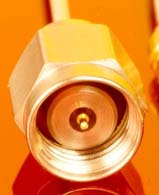
A close-up photo of the 1.85 mm male connector. Photo provided by Spectrum Elektrotechnik GmbH
Anritsu calls this the "V" connector.
V
The V connector is another Wiltron/Anritsu Corporation connector, developed in 1989. This connector uses a 1.85 mm geometry as established by public standards in 1988 (see above). It is compatible with the 2.4 mm connector as well. "V085" 50 Ohm is the intended coaxial cable for use with this geometry. Most UT085 coax will mode at 61 GHz and be more limiting than this connector.
1.0 mm Geometries
Modern millimeter-wave engineering and test instrumentation needs have been pushing towards measurements up to W band (70-110 GHz), without switching to waveguide . This geometry appears to satisfy that demand. The inner diameter of the outer conductor is a mere 1.0 mm, very tiny indeed!
1.0 mm
An HP (now Agilent) development, this 1.0 mm connector supports transmission and repeatable interconnections from DC to 110 GHz. Laboratory instrumentation technicians and engineers are beginning to use the 1.0 mm for millimeter-wave analysis. This connector is also often used on semiconductor probe stations for the evaluation of millimeter-wave RF MMICs. The use of coaxial connections greatly simplifies what would otherwise require several sets of waveguide-based measurements to a single step.
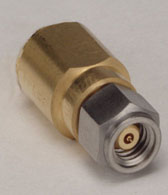
A close-up photo of the Agilent (HP) 1.0 mm male connector.
The dielectric diameter is only 1 millimeter
W
The W connector is a Wiltron/Anritsu Corporation connector, developed in 1996. It is meant for use on UT-47 cable and with probe stations. The design is meant to be as simple as an SMA - with reasonably easy installation while allowing operation up to 110 GHz. This connector shares characteristics with the HP 1.00 mm (see above).
Matable Connectors
| Connector Type | N | BNC | TNC |
|---|---|---|---|
| Type N standard | 11 Ghz | Can mate, not recommended | Can mate, not recommended |
| Type N without slots | 18 Ghz | Can mate, not recommended | Can mate, not recommended |
| BNC | Can mate, not recommended | 4 GHz rated, works to 11 Ghz | mating possible, not recommended |
| TNC | Can mate, not recommended | mating possible, not recommended | 11 GHz |
| Connector Type | SMA | 3.5 mm & WSMA | 2.92 and K |
|---|---|---|---|
| SMA | 12.4, 18 or 26 Ghz depending on design | Same as SMA Useable to 24 GHz * Note possible damage | Same as SMA Useable to 24 GHz * Note possible damage |
| 3.5 mm & WSMA | Same as SMA * Note possible damage | To 34 Ghz | To 34 GHz |
| 2.92 mm & K | Same as SMA * Note possible damage | To 34 Ghz | To 46 GHz |
* See text above regarding mating SMA Males with Precision SMA females.
| Connector Type | V Connector | 2.4 mm | 1.85 mm |
|---|---|---|---|
| V | 65 Ghz | 50 Ghz | 65 GHz |
| 2.4 mm | 50 Ghz | 50 Ghz | 50 GHz |
| 1.85 mm | 65 Ghz | 50 Ghz | 65 GHz |
Torque for tightening connectors
| Connector type | Torque lb-inch (N-cm) | Comment |
|---|---|---|
| Precision 7mm | 12 (136) | Finger tight is acceptable |
| Precision 3.5 mm , 2.92 mm & Anritsu "K" | 8 (90) | When connecting SMA to 3.5 use torque for male connector |
| SMA | Brass 3-5 (33-56) Stainless 7-10 (78-110) | When connecting SMA to 3.5 use torque for male connector |
| SMC | 3 (34) | . |
| Precision 2.4 mm | 8 (90) | . |
| Precision 1.85 mm and Anritsu "V" | 8 (90) | . |
| Precision 1.0 mm | 3 (34) | . |
| Type N | 12 (136) | Finger tight is acceptable |
| 7/16 | 225 (2500) | This is a very hefty amount of torque |
| TNC | 12-15 (136 -170) | Finger tight is acceptable |
Other sites that you might want to visit
For a calculator that gives the cutoff frequency for coax click here. The VHFSOUTH site has a bunch of usefull material.
A listing of Manufacturers is available at this NASA site.
The Agilent (formerly Hewlett Packard) products page which continues to change, and now has burried connectors and adapters as though they are only accessories to network analyzers. It is probably best to just search on the appropriate terms on their site.
When the founders of Omni-Spectra broke off from M/A-Com in 1981 they formed a new company called Southwest Microwave. They specialize ONLY in the high-end connectors and adapters. Press here for the Southwest Microwave website and in the PRODUCTS section, browse for various details. A big thanks to David Shaff for this reference.
M/A-Com, who used to be a leader in the highest performance connectors was bought by Tyco, and the connectors were moved toAMP who has a much smaller and lower performance selection only to SMA
Anritsu(Wiltron), select "Products" then Components & Devices, Instrumentation Grade Adapters, and then choose K&V Connectors or W1 Connectors for example. It describes connectors along with photos
Connecting Devices, Inc. is now a division of Tensolite called Carlisle, click here
Gilbert Engineering with the GPO connector is now a division of Corning.
SRI Connector, a company that sells precision connectors, adapters, and gauges.
Spectrum Elektrotechnik GmbH sells precision connectors including SPM, SBX, SBY and SSPO.
Maury Microwave, another company that sells precision connectors, adapters, and gauges.
Fairview Microwave, a company that sells precision connectors, adapters, and cables.
Apparently Electronika Inc is no longer in existence. If you know otherwise, please advise me.
[Wikepedia has a page about RF connectors with some other references, check it out. ](<A HREF=)
I have been asked about the handling power of connectors, and have very little information at this point but will be gathering it. The N connector is specificed in a variety of ways, but according to the original specifications it can only handle 600 watts!! Here is one amateur reference andhere is another from Amphenol.
If you have corrections, additions, or other useful tables, send e mail to
This page developed by WA1MBA. It is meant for reference use. Do not copy or publish without permission and citation. If asked, permission is usually granted for educational, internal commercial, and reference use.
Thanks to Tom Kilbourne of Anritsu for assistance with history on the K connector.
For a calculator that gives the cutoff frequency for coax, click here. Also, on this site the VHFSOUTH site has a bunch of usefull material.
This page was last updated 8/26/17.
